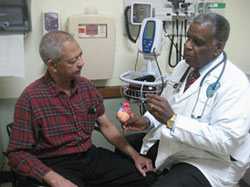Strong Men Put Their Heart Health First
 The perfect gift this Valentine’s Day is the gift of heart health. Along with Valentine’s Day, February marks American Heart Month, a great time to commit to a healthy lifestyle and make small changes that can lead to a lifetime of heart health.
The perfect gift this Valentine’s Day is the gift of heart health. Along with Valentine’s Day, February marks American Heart Month, a great time to commit to a healthy lifestyle and make small changes that can lead to a lifetime of heart health.
Heart disease is the leading cause of death for men and women.1 While Americans of all backgrounds can be at risk for heart disease, African American men, especially those who live in the southeast region of the United States, are at the highest risk for heart disease.2 Additionally, more than 40 percent of African Americans have high blood pressure, a leading cause of heart disease and stroke.3 That’s why this February during American Heart Month, Million Hearts® is encouraging African American men to take charge of their health and start one new, heart-healthy behavior that can help reduce their risk of heart disease and stroke.
Small Changes Can Make a Big Difference
African American men can make a big difference in their heart health by taking these small steps during the month of February and beyond.
- Schedule a visit with your doctor to talk about heart health. It’s important to schedule regular check-ups even if you think you are not sick. Partner with your doctor and health care team to set goals [275 KB] for improving your heart health, and don’t be afraid to ask questions [178 KB] and trust their advice.
- Add exercise to your daily routine. Start off the month by walking 15 minutes, 3 times each week. By mid-month, increase your time to 30 minutes, 3 times each week.
- Increase healthy eating. Cook heart-healthy meals at home at least 3 times each week and make your favorite recipe lower sodium. For example, swap out salt for fresh or dried herbs and spices.
- Take steps to quit smoking. If you currently smoke, quitting can cut your risk for heart disease and stroke. Learn more at CDC’s Smoking and Tobacco Use website .
- Take medication as prescribed. Talk with your doctor about the importance of high blood pressure and cholesterol medications [1.6 MB]. If you’re having trouble taking your medicines on time or if you’re having side effects, ask your doctor for help.

Mr. Ancar with cardiologist Dr. Ferdinand, a physician who specializes in heart disease.
Strong Men Make Heart Health a Priority
After undergoing triple coronary bypass surgery in 1999, Louisiana native, Clarence Ancar made the decision to make his heart health a priority. Before he had surgery, Clarence knew he had high cholesterol but had dismissed his doctor’s advice on adopting a healthy lifestyle and taking his medication. Clarence’s cardiologist, Dr. Keith C. Ferdinand, taught him that heart disease was not a death sentence and that he could still live a long, healthy life if he committed to making a few changes and respected his heart condition. Working together with his health care team, Clarence developed a plan to start and stay heart healthy.
By setting small, achievable goals and tracking those goals, Clarence made a big and lasting difference in his health. He learned the importance of taking his high blood pressure and cholesterol medications. With the help of a dietitian Dr. Ferdinand referred him to, he started eating less of the fatty, salty, and greasy food and added more fruits and vegetables. He also began walking 2-3 miles each day. After his surgery, Clarence lost a significant amount of weight and kept it off.
Today, Dr. Ferdinand continues to motivate and support Clarence in his heart health journey. By having a strong and trusting relationship with his doctor, Clarence was able to adopt and maintain a healthy lifestyle. Clarence encourages African American men to be strong and commit to making one heart-healthy lifestyle change during American Heart Month.
How to Support American Heart Month
Show your support for heart health by sharing messages on your social media platforms using #heartmonth and through these activities:
- Join Million Hearts® and Men’s Health Network on February 17, 2016 at 3 p.m. ET, for a Twitter chat on how to maintain a healthy heart, including tips for controlling blood pressure, eating healthy, and staying active. Use the hashtag #HeartMonthChat.
- Be part of our #HeartMonth Facebook Challenge. Each week, we’ll challenge you to complete one action that can help you maintain a heart-healthy lifestyle. Visit the Million Hearts® Facebook page to learn more.
- Keep the conversation going offline by talking about the importance of heart health with your friends, neighbors, and loved ones. Turn your next get-together into a healthy get-together! Download the Healthy Get-Together Planning Guide [3.94 MB].
Tools to Support Heart Health
Visit the Million Hearts ® website to find tools that can help you set heart-healthy goals that last a lifetime.
- Use the Million Hearts ® My Personal Health Progress guide [275 KB] to set realistic, achievable health goals.
- Track your blood pressure using a Blood Pressure Wallet Card [920 KB] and share results with your doctor regularly.
- Keep track of important medical information, such as family medical history, medications, hospitalizations, and surgeries with the Million Hearts® Health Resume [1.57 MB].
Healthy is Strong
To help address the health disparity that exists in African American men and heart disease, the CDC Foundation partnered with Pfizer and Quest Diagnostics to launch the Million Hearts® Healthy is Strong initiative.The goal of the initiative is to raise awareness about prevention, particularly among African-American men, as well as promote patient engagement with the healthcare system. The Healthy is Strong initiative provides African American men a suite of culturally-tailored materials to help them learn how to live heart healthy.
References
- CDC. NCHS. Deaths, percent of total deaths, and death rates for the 15 leading causes of death in 10-year age groups, by race and sex: United States, 1999-2013 .
- Yang Q, Zhong Y, Ritchey M, et al. Predicted 10-year risk of developing cardiovascular disease at the state level in the U.S.Am J Prev Med . 2014;48(1):58-69. PubMed abstract
- Nwankwo T, Yoon SS, Burt V, Gu Q. Hypertension among adults in the United States: National Health and Nutrition Examination Survey, 2011–2012. NCHS data brief, no 133 . Hyattsville, MD: National Center for Health Statistics. 2013.
- Page last reviewed: February 10, 2016
- Page last updated: February 10, 2016
- Content source:
- National Center for Chronic Disease Prevention and Health Promotion, Division for Heart Disease and Stroke Prevention
- Page maintained by: Office of the Associate Director for Communication, Digital Media Branch, Division of Public Affairs




 ShareCompartir
ShareCompartir